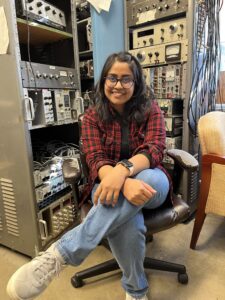Laser-focused on atomic research
Posted by Peter Ehrhard

Shruti Majumdar, a graduate student at Missouri S&T, works on the tapered amplified diode laser in the lab of Dr. Daniel Fischer, associate professor of physics. Photo by Michael Pierce/Missouri S&T.
Graduate student Shruti Majumdar is building her Ph.D. dissertation on two award-winning research projects that she has already presented. Both focus on the exploration of the few-body problem – where multiple particles interact in unpredictable ways in ion-atom collisions.
In 2023, Majumdar earned second place in Missouri S&T’s Shearer Prize competition, which recognizes the best research conducted by graduate students in physics for her project, titled “Separation of PCI from non-PCI higher order effects in ionization of helium by proton impact,” which involved her using a linear particle accelerator.
Majumdar says that a few-body problem arises as you can’t solve Schrödinger’s equation for more than two mutually interacting particles, even when the underlying force is known.
“Few-body problems are easier to explain than to research,” says Majumdar. “For example, if you drop a ball, that involves principles everyone understands such as velocity, but atoms don’t follow the same rules. Therefore, our research theory must rely on heavy modeling.”
In 2024, her project, titled “Multiply differential study of vibrational dissociative capture in p+D2 collisions,” also earned second place in the competition. This project involved studying the patterns created when a proton collides with deuterium, a type of hydrogen made up of two atoms.
Despite two awards and publishing these research projects in American Physical Society journals, Majumdar says that she still finds running experiments hard, especially not coming from a more hands-on electrical background for laboratory work.

“Since my undergraduate days, I always felt like other students were smarter than me,” says Majumdar. “But I really believe anyone can succeed in physics. Enjoy what you do, and it will give you an answer – if you put in the time and engage in research, you will find a breakthrough.”
Majumdar initially chose to major in physics with no specific expectations, but she quickly found the subject so fascinating, she says, that it inspired her to pursue it further.
“I always enjoyed studying physics and kind of ended up here in Rolla because of that,” says Majumdar. “When I first visited campus, Dr. Michael Schulz and Dr. Daniel Fischer in the department made everything look so fun I knew I wanted to be at S&T.”
Majumdar hopes to go into a research and development position once she graduates and catches up with her husband, Dr. Arindam Khanda, a post-doctoral fellow in the computer science department at Missouri S&T. But she says she wouldn’t mind if she ended up full-time teaching in higher education someday.
“I have enjoyed my time teaching the undergraduate students,” says Majumdar. “I love seeing the delighted faces of the students as they grasp the concepts and can come up with answers – those moments really bring a deep sense of fulfillment, rejuvenating me from within.”
About Missouri S&T
Missouri University of Science and Technology (Missouri S&T) is a STEM-focused research university of over 7,000 students located in Rolla, Missouri. Part of the four-campus University of Missouri System, Missouri S&T offers over 100 degrees in 40 areas of study and is among the nation’s top public universities for salary impact, according to the Wall Street Journal. For more information about Missouri S&T, visit www.mst.edu.
My heartiest Congratulations to you Shruti. Hope that you will do more in the same field.
Deuterium is not a type of hydrogen made up of two atoms. It is an isotope of hydrogen with a neutron in the nucleus in addition to the one proton that is in the nucleus of all hydrogen atoms.
NO NEED TO POST THIS REPLY FOR PUBLIC CONSUMPTION
Not sure what a “few-body” is, but this a great example of the kinds of cool stuff that goes on at Rolla–even if this involves Physics.
Did she and her husband also do their undergrad and/or post grad studies at Rolla? Always interested in hearing what draws students to attend Rolla.
Jim Rau
UMR BSCE 12/78